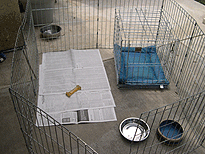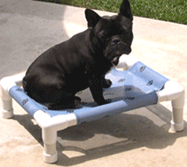|
READY FOR A NEW FRENCH BULLDOG? |
|
|
These are suggestions recommended to new owners or anyone. |
|
| A Word on Veterinarians, be careful and chose a vet that is familiar with Bulldogs and bull breeds. Also beware vets will take advantage of new Frenchie owners. Thay may cause you to distrust your breeder's advice or perform expensive and unceccessary tests. Some will even recommend surgery. Make sure to always check with your breeder first before proceeding with any tests or procedures with a new Frenchie. Keep in mind many Frenchies are noisy breathers and that can change with maturity. It is also typical and considered part of their character. However, your Frenchie should not be in distress. | |
|
Food and Water Examples of dry food: (Avoid protein exceeding 28%)
|
If you just got a new puppy, ask the breeder
to send some food along with the pup, they're already eating. Use
the same food until it is recommended to change it. If you plan on
changing their food anyway or their current food is hard to locate, try
whole basic bland foods and gradually combine a new puppy food (follow same
suggestions as listed above in "Common Questions"). A puppy
typically eats about 3 to 4 times a day, depending on their age. You
may choose to reduce that eventually to one to two times a day as they mature.
It is not a good idea to allow your Frenchie to become overweight.
It is a good idea to take water from the breeder of the puppy, if possible. If not use bottled water until you can gradually add your own water to avoid any discomforts. Otherwise you may get loose stools or worse until your puppy becomes adjusted to your water. |
|
Bowls for eating and drinking
|
Most recommend stainless steal bowls that last, is safe and does not retain odors or bacteria, and will go in the dishwasher. Pups I like to use a heavy stone pottery for a water bowl so they don't knock it over. Feeding weaned pups, I use a short or puppy pans. Frenchies having short noses, in deep bowls may not get as much air. Water bowls I have no issue, they are deep so there's always plenty. This stainless steel bowl has a partially chewed Nyla-bone in it. Notice the sides are slanted. Sometime there's a problem with the bowls sliding on the floor. They do have stainless steel bowls with rubber bottoms so they don't slide. These bowls can be hard to find check feed stores and dog show supply outlets like Davis and PVS.. |
|
Wire or enclosed crate 200 size or medium size
|
This doubles as your puppies home or bed and a place to be safe. It is not unfair since dogs are den animals. They will become accustomed to their new portable den also known as, the crate. This is also a good way to transport your Frenchie safely. To get your puppy use to the crate, leave the door open and place the crate in a family room. This way the puppy can feel more comfortable trying out his new home. Of the several types of crates, I think for pups wire is best so they don't chew on it. They can see all around them in a wire crate. To avoid a draft with the crate you may place a towel or blanket over it. Closed crates are also good and in cooler weather and may seem more secure to some dogs. |
| X-pen (exercise pen) |
This is about a 4 X 4
wire pen that folds up and can be adjusted to varying sizes. It is
recommended to get at least a 24 to 30 inch height. Very handy when
traveling and cordoning off area you don't want your Frenchie to go.
This is also helpful when introducing a new pet into your home. The
crate inside the pen becomes a bed like a protective home with a small yard.
It is not recommended to leave your puppy loose and unattended when not at home. Many things can get damaged in your home and the pup could chew on an electrical cord amongst other things. |
| Newspaper or tray with fake grass |
Lots of newspaper - To assist with potty training. However I do not care for newspaper and started using a potty tray to train puppies. Keep paper one side of the X-pen at night and during the day. Or use a tray or pan big enough to help teach your dog where to go, when they are unable to go outside. Rolling up a newspaper: When correcting your dog try using the old fashion method of a rolled up newspaper or flyswatter. Hit the floor or wall, getting their attention and use a corrective tone. Another harmless, corrective tool is a squirt bottle of water. Note: It is important to reward your puppy when they do something favorable. Hugs and kisses and lost of praise goes a long way. |
|
The Perfect Set Up
|
This is what I recommend for a pup or young dog when you're away from home possibly at work during the day or at bedtime. Have an area in your home (preferrably without carpet) and if you don't, you can buy a piece of lanolium flooring at a home store, to put down. Set up your X-pen and put the crate one one side inside the X-pen. Put newspaper on the opposite side of the crate. Put a sturdy water bowl and safe dog toy in the pen. Have a safe and cozy bed in the crate and leave the create door open. Don't expect your puppy to learn so fast. This set up works well.. |
|
A Cozy Bed
|
Have a nice comfy bed for snuggling and to keep warm. A good bed is where they can't get to the stuffing and either the cover or entire bed can be put in the washing machine. These are my favorite dog beds. They are made in northern California by "Body Gear for Pets" 707-795-5196. They are soft, they last, wash well and don't fall apart. You have a choice of different colors and fabrics. This is a size 29 and sometimes two Frenchies will sleep in it. Best of all the dogs love em. |
|
Fun Bed in Doors or Out
|
This bed they really like and doubles as a toy box. They really enjoy being outside or in front of the fireplace in this one. This bed is elevated and keeps the dog off the hard floor. Contact www.doggieloungers.com for more information. This is a small one the next size up, two or more can fit on. |
|
Chew toys
No Greenie or cooked bones that can chip or splinter |
All babies especially
when teething even the adults will chew. Puppies will chew anything
and everything so be careful. It is very important they have enough
chew toys to keep them busy. Get new chew toys from time to time to
keep their interest. Note: It has often been recommended to not give your dogs rawhide chew bones or toys. |
|
Benadryl Allergy, Zertec (over the counter) I like to use children's liquid Benadryl and a syringe |
Often is recommended
by vets for minor allergic reactions. Benadryl will also relax your dog
and can make them drowsy. Please consult your vet in advance and for
dosage information.
Note: Bee stings can be highly reactive and should contact your vet |
| Bag Balm (utter cream) or Vaseline | Recommended moisturizer for noses, other areas and minor skin irritations. |
| Wash rag and mild antibacterial soap | Wash your French Bulldog's face and folds regularly. |
|
Toe nail clippers or nail grinder
|
It is always a good idea to keep in the habit of cutting or having your dogs toe nails trimmed. When you start hearing the sound of "clip-itty-clip" is when it's time to trim them down a bit. |
| Moisturizing Shampoo for bathing your Frenchie | Frenchies are easy to bathe just toss them in the sink or tub, wash, rinse, towel dry and away they go. Use a mild dog formulated shampoo or vet recommended allergy shampoo. Conditioner is often helpful for rough, dry coats. |
| Antiseptic Ear wash - flush | Frequently check your Frenchies ears and try and keep them flushed and cleaned regularly. Make this a part of your routine after bathing your Frenchie and always use cotton. Try a feed store, pet store or vet for a most often used antiseptic ear wash. |
| Small Hair Clippers (optional) | Often show exhibitors shave their Frenchies muzzles however, is a nice and neat habit if you prefer. |
| Know your dog's schedule for shots and keep them current | Some areas of the country have different concerns protecting against virus not common in other regions. If your puppy was shipped may not have been inoculated for potential parasites or diseases in his new area. Be careful of Rabies shot reactions and inform your vet some Frenchies react adversely to LEPTO and may choose to avoid this. |
| Keep your dog wormed regularly and if concerned get a fecal examination performed by your vet. | If you find like rice or white parasites or if you have fleas, worms once they get out of control can be very devastating to your dog(s). Common symptoms of exposure are skinny, pot-belly and slowed growth. They have difficulty putting on weight and coats are flaky, dry and dull. Do not let worms get a hold of your dog and can spread like an epidemic to other pets. Curing one pet does not cure the epidemic and may require all your pets to be examined. |
|
French Bulldogs are primarily an indoor breed. If your new French Bulldog is still quite young, say under four months of age limit their exposure to foreign places and other dogs. Dog parks are fun, but keep in mind Frenchies can be fearless and get into trouble with strange or larger dogs. They also have a tendency of going with just about anybody. Consider having your French Bulldog micro chipped just in case by a veterinarian. Make sure to keep your Frenchie out of the heat and the extreme cold. Take caution when exercising with your Frenchie and not let them overheat or over exert themselves. They often do not know their own limitations. Avoid the heat of the day or for too long or too vigorous exercise. If your Frenchie starts to over heat, hose them down with cold water or use wet towels to calm them down. If you're planning a long walk take periodic breaks. When returning from a long or hot walk, play or exercise and your Frenchie drinks a lot of water, get ready it most often comes back up. Help them moderate their water intake and don't be alarmed if this happens. Enjoy your new Frenchie because very soon they'll be your best friend for a very long time. |
|




